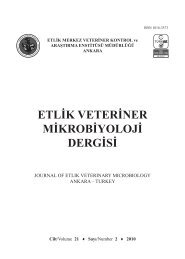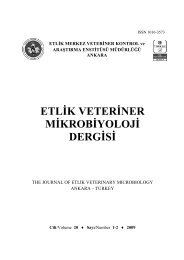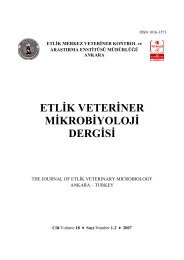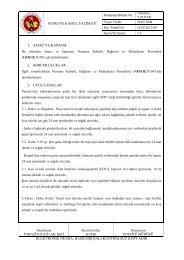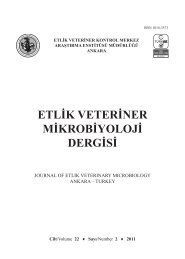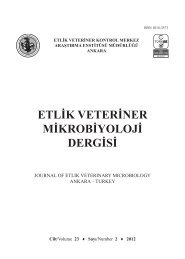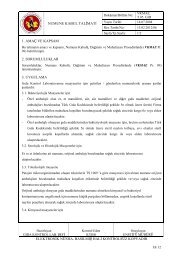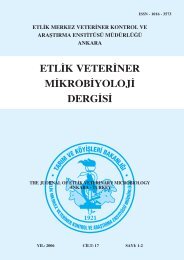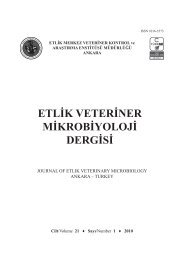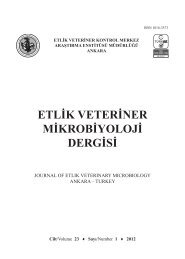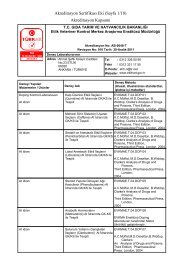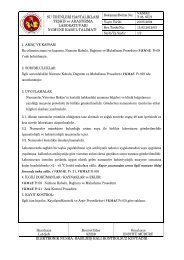Cilt/Volume 19 Sayı/Number 1-2 2008 - veteriner kontrol merkez ...
Cilt/Volume 19 Sayı/Number 1-2 2008 - veteriner kontrol merkez ...
Cilt/Volume 19 Sayı/Number 1-2 2008 - veteriner kontrol merkez ...
You also want an ePaper? Increase the reach of your titles
YUMPU automatically turns print PDFs into web optimized ePapers that Google loves.
Figure 1. Waterfowl immigration routes (Sabirovic et al., 2006).<br />
Material and Method<br />
Viruses. Total 173 virus isolates were used in<br />
this study (Table 3). The virus isolates analyzed in<br />
this study were isolated from domestic backyard<br />
and wild birds from the infected premises in<br />
Turkey. Viruses were detected by virus isolation in<br />
embryonating chicken eggs (ECEs). The isolates<br />
were typed as HPAI H5N1 viruses by<br />
hemagglutinin inhibition (HI) and neuraminidase<br />
inhibition tests with a panel of reference antisera<br />
(OIE, <strong>2008</strong>). Viruses were received by the<br />
Veterinary Control and Research Instituties in<br />
Turkey (Bornova / İzmir, Pendik / İstanbul and<br />
Etlik Central / Ankara) in the form of tissue or<br />
allantoic fluid from 9-10 day-old SPF embryonated<br />
chicken eggs or RNA extract.<br />
RNA Extraction and Reverse Transcriptase<br />
Polymerase Chain Reaction: RNA was extracted<br />
Etlik Veteriner Mikrobiyoloji Derg, <strong>19</strong>, <strong>2008</strong> 29<br />
using QIAamp RNA extraction kits (QIAGEN,<br />
Germany) according to the manufacturer’s<br />
instruction. Primers were selected to recognise<br />
regions of hemagglutinin gene of the Avian<br />
Influenza A Virus as described by WHO<br />
(www.who.int/csr/diseases/ai). Amplification was<br />
performed with the forward primer H5F (5’- GCC<br />
ATT CCA CAA CAT ACA CCC -3’) and reverse<br />
primer H5R (5’- CTC CCC TGC TCA TTG CTA<br />
TG -3’). All reactions were performed using<br />
SuperScript III One-Step RT-PCR System with<br />
Platinum Taq DNA according to the manufacturer’s<br />
instruction (Invitrogen, USA). The PCR amplicons<br />
were visualised by Ethidium bromide staining after<br />
electrophoresis through 2% agarose gel (Sigma-<br />
Aldrich, Germany). The PCR products were<br />
separated in an agarose gel by electrophoresis and<br />
purified using QIAquick gel extraction kits<br />
(QIAGEN, Germany).



